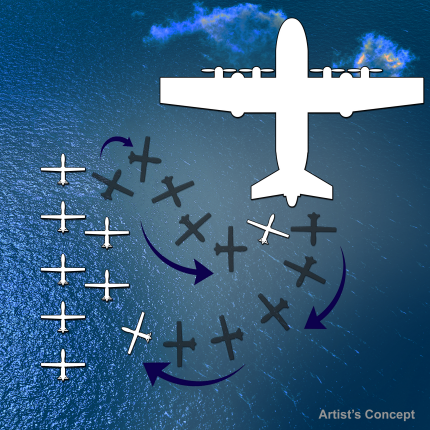DARPA wants to turn large planes into aircraft carriers for UAS
The agency is looking for ideas on how to adapt aircraft such as a C-130 or B-52 to enable small unmanned aircraft to go on long-range missions.

A DARPA illustration depicts the general idea of a UAS carrier.
The Pentagon would like to use smaller unmanned aerial systems on long-range missions, particularly missions that pose a threat to military personnel or large, expensive aircraft. The problem is getting those small UAVs there, since they don’t have the range or speed for long-distance operations.
The Defense Advanced Research Projects Agency has an idea for a possible solution: retrofitting existing large aircraft—such as the C-130 transport plane or the B-52 bomber—to transport unmanned systems to their destination, send them off like so many fighters from an Imperial Star Destroyer and then collect them back on board after the mission.
The agency has issued a Request for Information to industry looking for ideas on the technical, security and business feasibility of making large planes ready to handle multiple small UAS, each of which would weigh less than 100 pounds,
“We want to find ways to make smaller aircraft more effective, and one promising idea is enabling existing large aircraft, with minimal modification, to become ‘aircraft carriers in the sky’,” Dan Patt, DARPA program manager, said in a release. “We envision innovative launch and recovery concepts for new UAS designs that would couple with recent advances in small payload design and collaborative technologies.”
DARPA said such an approach could increase the range of UAS operations while improving safety and cutting costs, and could lead to new capabilities in ISR (intelligence, surveillance and reconnaissance) and other missions.
Specifically, the agency is looking for system-level technologies and concepts for adapting existing planes for airborne launch and recovery of small UAS, with a minimum of modification. DARPA expects that modeling, simulation and feasibility analysis will likely be used in developing these concepts.
Also on the list are potentially high-payoff operational concepts and mission applications that would apply to a distributed airborne approach, and how they compare to conventional approaches. DARPA said it wants to leverage investments in precision-relative navigation and the coordinated flight activities that type of navigation enables.
DARPA is hoping to see full-system flight demonstrations within four years, and is looking for help in planning this approach as a possible future DARPA program. The agency is looking for ideas on what could realistically be achieved within that timeframe.
Responses to the RFI are due Nov. 26.
NEXT STORY: Boeing claims new anti-jam capability